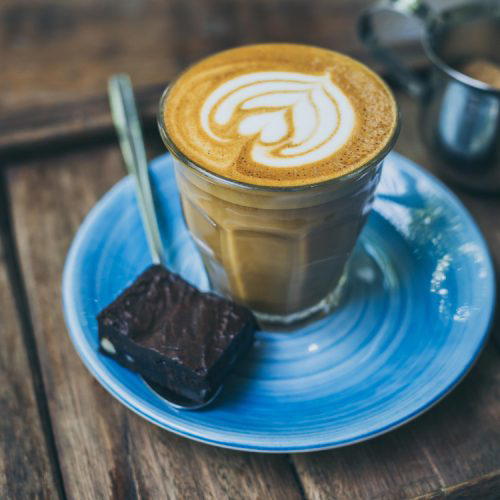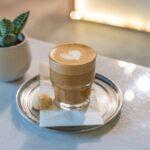Imagine you are scanning through the menu of a café. Options available are:
- Cappuccino
- Espresso
- Piccolo latte
- Latte
- Cold brew
Chances are, you ignored Piccolo latte among these. You aren’t alone! While the Piccolo latte might be less popular, it is a unique coffee type. Read on to find out why!
What is Piccolo coffee, and why is it special?

Piccolo coffee is made special by the ristretto shot mixed with milk. The shot measures 15 to 20 ml (0.5 fl oz. to 0.7 fl oz.).
A small quantity doesn’t necessarily mean mild taste as it is concentrated. Concentration is retained due to finely ground coffee beans. The shot results in less retention of water. Piccolo latte also has numerous other traits covered below.
1. Strong flavor
A concentrated shot means a strong flavor. Besides the shot, the milk content is limited, which doesn’t dilute the taste as much as a regular latte, resulting in a strong flavor.
2. Less fulfilling
Two ounces of non-fat milk results in 22 calories. A similar quantity of 2% milk results in 30 calories. That is precisely what the piccolo latte offers – a strong taste with fewer calories.
3. Eliminates acidity
Bigger coffee shots offer better taste retention with the risk of higher acidity. According to a study by Rao and Fuller, the pH level of a typical cup of hot brew coffee is between 4.85 to 5.13, which is considered acidic.
While the Ristretto shot has a similar pH level, two factors work in its favor:
- A limited quantity of shots in a piccolo latte limits the acidity by volume.
- It’s usually mixed with milk (pH level: 6.5 to 6.7) which reduces overall acidity.
Anyone experiencing the urge to drink a piccolo latte by now can follow the recipe below.
How to make Piccolo coffee?
Heading to local coffee shops that offer a piccolo latte isn’t always viable. Better to make it at home with the equipment below:

How to make Piccolo coffee?
Equipment
- 1 coffee maker
- 1 Demitasse glass if you’re feeling fancy, otherwise a normal cup will do
Ingredients
- 20 grams dark roast coffee beans same amount as a normal espresso shot
- 1 oz. filtered water
- 2 oz. milk or non-dairy alternative
Instructions
- Add the ground coffee to the machine.
- Tamp it as you would with an espresso shot
- Pull the shot for only 20 seconds and pour it into a cup
- Froth your chosen milk for 30-60 seconds and pour over the Ristretto shot
Notes
That’s it!
Piccolo latte consists of a single ristretto shot (one part) and two parts of frothed milk.
If you’re having trouble with milk consistency, try any of the techniques below.
Tips for frothing milk to the right consistency
Technique 1: Use a milk frother
An automatic milk frother makes foamed milk and heats it to the right temperature. My recommendation is Paris Rhone Milk Frother to create froth using the procedure below:
Step 1: Pour in the milk and select the foam mode (Dense foam, Fluffy Foam) as per preference.
Step 2: Pour foamed milk into your cup by keeping the jug and glass straight. Ensure a gap of 5cm (2 inches) between the jug and the cup.
Technique 2: Use a whisk
Do not want to buy an appliance to make milk foam? If so, use a whisk instead. I strongly recommend an electric whisk like this one, it would save you a lot of hassle in the long run.
Step 1: Heat milk up to 60°C (140°F) (check with a food thermometer).
Step 2: Whisk the milk for 30 seconds and pour it into your cup.
Truth be told, whisk generates less foam as compared to the other two methods. However, if you do not have any of the above two appliances, it will still help you make decent coffee.
Technique 3: Use a French press
The French press is usually used for brewing coffee, but it does work as a milk frother if you’re in a pinch! The difficulty here is heating the milk.
Step 1: Heat the milk, if you have a food thermometer, look out for 60°C (140°F).
Step 2: Pour it into a French press and generate foam bubbles using short plunges for about 30 seconds. After that, shift it to the pitcher.
Step 3: Pour the milk into the Demitasse glass, which contains the ristretto shot.
When plunging, try to control how high you pull the plunger. Aim for the milk surface. If you pull too high, it would create large bubbles which reduce the creamy texture.
Tips for making the perfect cup of Piccolo coffee
1. Keep quantity between 20-30 ml (0.7 fl oz to 1 fl oz).
2. Allow enough air to create micro-foam.
3. Pour from 5cm (2 inches) to mix milk nicely with the ristretto.
4. Choose either hazelnut/caramel/chocolate coffee for proper flavors. Avoid fruity coffee flavors
5. Stick to full cream milk (milk alternatives: oat milk, almond milk).
6. Ensure the steaming temperature of 60°C (140°F).
Conclusion
Next time you want to surprise your palette of coffee, go for a piccolo latte. It is not difficult to make and it certainly is different than ordinary cappuccino or lattes served by most coffee shops.
FAQs
Is piccolo coffee stronger than a latte?
A piccolo latte is stronger than a latte because of less water in the ristretto shot. The small piccolo latte size makes it concentrated and stronger than a regular latte.
How many shots are in a Piccolo?
Piccolo latte consists of a single shot of ristretto, approximately 20 ml (0.7fl oz). It is similar to a typical espresso shot.
What is the difference between a piccolo and a macchiato?
Piccolo latte consists of more milk than macchiato. The ratio of ristretto shot to steamed milk is 1:2, whereas macchiato consists of only espresso and milk foam topping. A macchiato is the best bet if you want an undiluted flavor of an espresso shot with something to break the taste monotony.
What is the difference between a piccolo and an espresso?
Piccolo latte consists of a ristretto shot and not espresso. Ristretto uses less water and is also smaller than espresso. However, the bitter taste is more pronounced in espresso. On the flip side, ristretto has less caffeine content. The differences might be subtle, but the taste difference is drastic.
What kind of coffee is piccolo?
Piccolo coffee is a latte made from a ristretto shot derived from roasted coffee beans that are finely ground. The latte is typically served in a demitasse glass with steamed milk up to the top. The shot size is limited to 20 ml.






